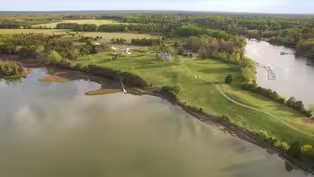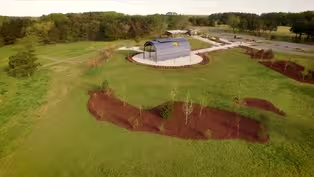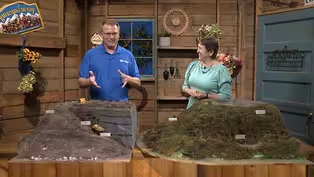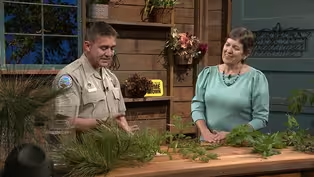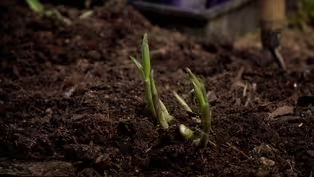Virginia Home Grown
Mine Land Reclamation
Clip: Season 23 Episode 2 | 7m 57sVideo has Closed Captions
Learn about a mining company’s industry-leading environmental stewardship program.
Peggy Singlemann explores the land reclamation site at Kyanite Mining Corporation in Buckingham County. President Guy Dixon, and Environmental & Safety Director John Snoddy explain the company’s award-winning approach to environmental stewardship that reclaims mine land for wildlife habitat. Featured on VHG episode 2302; April 2023.
Problems playing video? | Closed Captioning Feedback
Problems playing video? | Closed Captioning Feedback
Virginia Home Grown is a local public television program presented by VPM
Virginia Home Grown
Mine Land Reclamation
Clip: Season 23 Episode 2 | 7m 57sVideo has Closed Captions
Peggy Singlemann explores the land reclamation site at Kyanite Mining Corporation in Buckingham County. President Guy Dixon, and Environmental & Safety Director John Snoddy explain the company’s award-winning approach to environmental stewardship that reclaims mine land for wildlife habitat. Featured on VHG episode 2302; April 2023.
Problems playing video? | Closed Captioning Feedback
How to Watch Virginia Home Grown
Virginia Home Grown is available to stream on pbs.org and the free PBS App, available on iPhone, Apple TV, Android TV, Android smartphones, Amazon Fire TV, Amazon Fire Tablet, Roku, Samsung Smart TV, and Vizio.
Providing Support for PBS.org
Learn Moreabout PBS online sponsorship>>Gentlemen, I have never been on a reclaimed mine site.
You know, I think of mine sites as open and barren areas.
But I've also never heard of Kyanite.
So, I've got so many questions to ask.
So, let's ask the obvious one.
Guy, what is kyanite?
>>Kyanite is a ceramic raw material that is useful for its high melting point and other heat-resistant properties.
>>And how did Kyanite Mining Company come about?
>>Kyanite Mining Corporation was founded in the mid 1940s, when my grandfather and great-grandfather bought the predecessor mine which had gone bankrupt several times during the Great Depression and tried to make a go of it right at the end of the Second World War.
>>So, is this the original mine that was purchased back then?
>>No, the original mine is located about 20 or 30 miles south of here as the crow flies at a place called Baker Mountain, which was the sole mining location for the company up until the early 1950s when they started this location up.
>>Okay, so they mined this location for how many years in this exact location we're standing at before the restoration started?
>>There was no actual mining going on right here where we are.
The mining takes place on that hill that you can see in the background, and a hill over that way, which you can't really see right here.
Where we're standing here is a deposit for all of the various mineral constituencies that are mined that aren't kyanite and that we have to do something with.
And so we're kind of moving the mountain from over there, over here.
>>We're standing on a new mountain.
>>That's right, that's right.
>>That's fantastic.
So, John, how do you start the process of reclaiming a barren mountain?
>>Peggy, our overarching goal is to ensure that no sediment leaves our site.
So, our first step is to create sediment control structures like sediment dams, rock filter berms, diversion ditches so if erosion occurs we can capture that sediment in these structures and prevent it from leaving our site.
And then those minerals that we don't sell as kyanite product, or a byproduct, start to be deposited behind that sediment dam.
And as that elevation increases, we spread topsoil on those layers, creating the grassy slope that we're standing on now.
>>So, what is that seed mixture?
And how do you determine that mixture?
>>Great question.
Our mixture is approved every year by the state of Virginia's Department of Energy.
And that typical mixture includes fescue, clover, lespedeza, and whatever cover crop we might choose for that time of planting.
As you can see, a lot of our site is slope-driven.
And so our seeding needs to be respective of that slope.
And our goal is to ensure that as soon as we apply that seed and that fertilizer mix, that the seed sprouts and holds that soil in place.
Remember I lead with, we don't want any erosion of our reclamation site.
So, our mix is designed to sprout very quickly, hold that topsoil in place and allow for the perpetual use by our wildlife.
>>So, you've put down basically an annual rye first because that, to me, is the fastest way to hold the slope immediately.
>>It is, and that comes up immediately, to your point.
But then the fescue and the clover and the lespedeza isn't far behind.
And that stabilizes the soil, while also to the clover mix, enriches the soil as years go on.
>>Yes.
Do you have to do any soil testing and any modifications of the soil while you're getting this space established?
>>We do soil sampling before we apply our seed and fertilizer and lime mix so that we know what that mix should be.
Our seed mix stays the same, but our fertilizer and our lime applications vary by what those soil samples recommend.
So, we might be seeding an acre or two at a time, maybe three or four acres.
And if the number is that high, three or four acres, we'll probably take three or four or five soil samples just in case there are areas within that topsoil spread that require a little more fertilizer or a little less lime.
>>Yes.
So, you're able to fine tune it.
You're just not blindly broadcasting things.
>>That's exactly right.
>>That is so good to hear.
Warms my heart.
But you also mentioned wildlife.
So, do you do any additional seeding to bring in more of the wildlife?
>>Great question.
So, we spoke with a wise horticulturalist just last week who suggested that in addition to the soil stabilization that our original seed mix supplies, we add in some native grasses and some native wildflowers so that as this site progresses into Mother Nature retaking it, it's hosting those native grasses and those native wildflowers.
So, our seed mix now and forevermore includes a native grass and a native wildflower mix.
>>Thank you, I appreciate it.
>>You're very welcome.
Thanks for the advice.
>>You're welcome.
But how long will you keep managing the site before you do let it go to Mother Nature?
>>We like to manage our sites for many years, I would say close to a decade after we create them to ensure that there is no differential settling, no erosion taking place on a section of grass that didn't come up as well as we had expected.
And that way, if we have to go back and make a patch here or there, we're not disturbing trees that might have sprouted.
And then once we're sure that the water is going where it should go, there's no erosion, that the seed mix is doing its job, then we will by all means let Mother Nature run its course.
>>I'm just so impressed by all the work that's here.
But, Guy, what prompted your family to initiate reclaiming the property, the land?
>>Well, that's a really important question.
It's just the right thing to do.
And so that's, in its essence, why we do it.
And there's lots of things about being part of a community that make you do various things.
And these reclamation projects are one of those.
But there's all kinds of ways that this company is involved in the community.
We're very active in supporting emergency services, which in a rural place like this, the volunteer fire departments and the volunteer rescue squads need all the help they can get.
And we're honored to be able to help.
To little things, like we have a trash pickup day where we get the whole company, give them the day off and pick up hundreds of bags of trash.
And so it's all those kinds of things wrapped into one.
But it all comes back to the fact that we all live here and are part of these communities.
And it's home, and you treat it like home.
>>I applaud you for doing that.
Because having the company be just part of the community and the community then becomes part of the company.
And there's a pride.
And I congratulate you.
>>Thank you.
>>Well, I understand from all of this hard work that you have done that you've won many awards.
>>Yes, we have.
And that's a point of serious pride for me and John and everybody who works here.
This is the latest project that we've done that we've won an award for.
I believe we've won the State of Virginia Best Reclamation Award here.
And we might be in the running, John knows better than I do, for a national award here.
And we have actually won quite a few state awards in the past and even two national awards for the original mine, Baker Mountain, brought back to a state of nature.
>>Well, what a great success story and I congratulate both of you.
And John and Guy, I thank you so much for the dedication and working a site and bringing it back and allowing it to eventually progress back into nature.
And I also thank you for sharing that.
>>Thank you.
>>Thank you.
Video has Closed Captions
Clip: S23 Ep2 | 26m 46s | Learn about efforts to protect and restore natural areas in Virginia! (26m 46s)
Video has Closed Captions
Clip: S23 Ep2 | 2m 19s | Conserve water and suppress weeds by using wood chips in the garden. (2m 19s)
Video has Closed Captions
Clip: S23 Ep2 | 7m 11s | Explore Virginia’s first state park dedicated to honoring Native American history. (7m 11s)
Video has Closed Captions
Clip: S23 Ep2 | 6m 39s | Overseeing Mine Site Restoration (6m 39s)
Video has Closed Captions
Clip: S23 Ep2 | 5m 55s | Learn about native tree species being encouraged to grow at Machicomoco State Park (5m 55s)
Video has Closed Captions
Clip: S23 Ep2 | 3m 7s | Preserve soil on sloped landscapes by planting groundcover. (3m 7s)
Providing Support for PBS.org
Learn Moreabout PBS online sponsorship

- Home and How To

Hit the road in a classic car for a tour through Great Britain with two antiques experts.












Support for PBS provided by:
Virginia Home Grown is a local public television program presented by VPM
